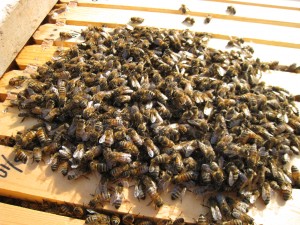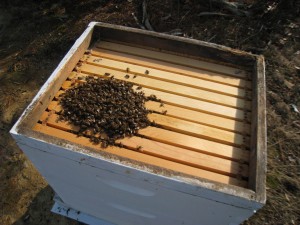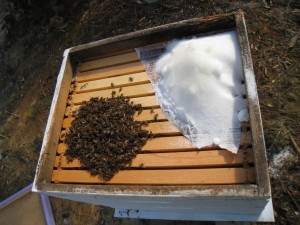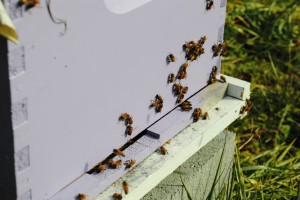Time and Weather Wait for No Man
Ideally, your typical beekeeper tries to manage his hives at or above 50 degrees F. Once you drop below 50, the bees are forming into a cluster (once she hits the mid-30’s, the full cluster is tightly formed). Opening a hive at that point can disrupt the cluster and expose your brood to low temperatures (killing it.) This is all well and good for the fellow who can look into his hives on any day that is suitable, but I am not in that boat.
Today, we do not expect the weather to get above 38 to the east of Richmond, Virginia. I work during the week and will be heading to Florida on a small vacation next weekend. Basically, Saturday (yesterday) was my last chance to look into the hives for at least 10 days or so. But, the temperatures were not expected to go above 49 degrees…
Well, temperatures be damned. I had things to do (as in hives that might be going into swarm mode!) and we’ll see if it has any long lasting negative consequences. For the most part, I tried to make my inspections quick, but some took longer then hoped. My primary goal for yesterday was to inspect the new Mosely Hive (Mandy, the lady whose property it is on, indicated that they were looking very active – as if they might be prepping to swarm), the Geronimo Hive and the Curly Hive for possible swarm activity. Finally, I wanted to look in on the weak/failing queen hive (I had decided that I would collect brood/eggs from one of my strong inspections to put in with the weak hive that had the siamese twins queen cells).
I found one queen cell in Geronimo – in the supercedure position. One queen cell in the middle of a frame does not a swarm cell make, especially at this time of the year. Although I never laid eyes on the queen, I did find eggs (standing straight up, which means (to me) that she was in action in the last 18 hours). Being greedy, I stole the frame with the swarm cell on it. Here was the only problem of the day – I could not find the queen in this box. She did not appear to be on the frame that I took, but I cannot guarantee it. The problem was the temperatures and the wind. Geronimo pretty much sits on a hill that overlooks Downtown Richmond and countryside to its southeast of the city, literally. It was really gusty and I knew that I was putting a lot of brood at risk messing around looking for the queen. I found several frames of eggs and decided that was enough. If I accidentally took the queen, the old weak hive would benefit from it and Geronimo would do just fine building a new queen.
Looking at the rest of the hives, I found no further evidence of swarm behavior (except a lot of Queen Cups in Curly). Finding the queens in both of these hives, I took a frame of brood, eggs and nurse bees with confidence (from both.) So, off to my weak hive to fortify it. Per the previous post, this (as yet unnamed) hive had a baseball-sized brood nest in early March, which only dwindled as the weeks went on. This is apparently the sign of a failing queen. Fortunately, I found two queen cells last weekend. Regardless, to be safe, I was bringing them 3 frames of brood, two with eggs and one with a queen cell on it.
I opened up the weak hive to find enough bees to cover 4 frames in the top and bottom supers – but only a handful of brood cells. I did pull the frame (carefully) with the Siamese queen cells and noted that both had been opened. 3 seconds later, on the same frame, I spotted the young princess! She was definitely not as big as most of my mature queens (but, it is highly unlikely that she had mated yet, which will make her abdomen bigger), but there she was – hopping about the frame, raising and lowering her abdomen (I think this was mainly to warm herself up.) This was encouraging, to be sure. I decided to give them one frame of brood with nurse bees (not the frame that might have the Geronimo queen) and take the remainder back to my house to start a ‘walk-away’ Nuc.
It will be interesting to see how this Nuc fares. Under ordinary circumstances (is there such a thing in Beekeeping?!), I would not try to start a Nuc on a day that is cool to begin with (probably at 45 degrees F when I finally put it together in my Nuc yard) which is going to be followed up by a day that will not get above 35 or so with rain/sleet to boot! It seems to me that the bees (from 3 different hives) are not going to get much time to organize themselves. The good thing is that we only have 36 hours of this mess, so hopefully there will be minimal casualties before they are able to take inventory and move on as a single hive.
As to the queen cell in the Nuc, I am ambivalent about it for the most part. In truth, I would sort of like them to be queenless for about 8 days, when I can drop a frame of eggs from a really good hive into them and let them start some queen cells for me. But, we’ll see how it goes.





